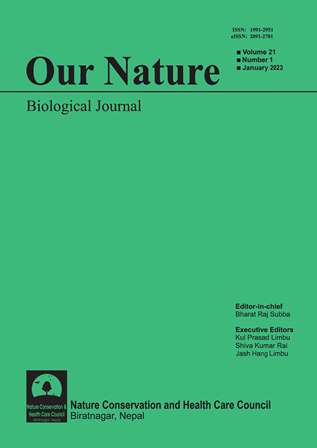Fecundity of Glyptothorax telchitta (Hamilton, 1822) from Tamor River, Nepal
DOI:
https://doi.org/10.3126/on.v21i1.50831Keywords:
Ganadolative fecundity, Gonado-somatic index, Egg SizeAbstract
The present study assesses the fecundity of Glyptothorax telchitta, a hill stream fish from the Tamor River, Nepal. A total of 60 specimens were collected from the Tamor River, with the help of local fishermen between March 2019 and February 2020. The absolute fecundity ranged from 3385 to 14298 eggs with the mean absolute fecundity of 9448.469 ± 607.783. The fish was found to be a medium fecund fish. Relative fecundity ranged from 151 to 529 eggs per gram body weight with mean relative fecundity of 371.38 ± 15.72. Fecundity showed significant positive correlations with ovary weight (r = 0.858) total length (r = 0.844) and total weight (r = 0.825). This indicated that fecundity dependent is mostly on ovary weight. Gonado-somatic index scored the peak values during March (15.15%) and May (15.01%), indicating the fish’s spawning period during the spring season. Egg sizes varied from 0.382 mm to 1.149 mm. The appearance of various sizes of eggs in a single ovary indicated that the fish was a fractional spawner. The ovaries occupied maximum space in the abdomen during the breeding season.
Downloads
Downloads
Published
How to Cite
Issue
Section
License
Copyright (c) 2023 Jwala Poudel, Jay Narayan Shrestha, Dipak Rajbanshi, Jash Hang Limbu

This work is licensed under a Creative Commons Attribution-NonCommercial 4.0 International License.
This license enables reusers to distribute, remix, adapt, and build upon the material in any medium or format for noncommercial purposes only, and only so long as attribution is given to the creator.




